Chapter 10. Coastal Alaska
Day 62-63 - July 16-17 - Kasilof River
(Bert) After spending one night at a Seldotna campground to recharge our
batteries and run the washing machine, we move to a parking lot at a State
Recreation Site on the Kasilof River. Shari has been monitoring the success of
the fishermen and is holding to her usual wait-and-see attitude, desiring mostly
to be a catcher and not just a fisher. Yesterday we didn’t see anyone bring back
salmon when they
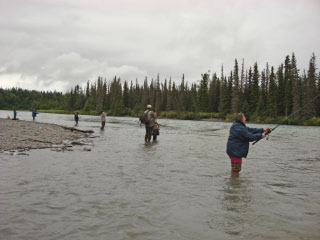 passed R-Tent-III on the way from the river to their parked
vehicles. Nonetheless, Shari assembled our fishing gear and went to the tackle
shop to buy more gizmos and do-hinkies to attach to the end of the line. She has
been calling the hotline and getting the daily salmon count at local rivers.
When she heard that 18,000 entered the Kasilof River yesterday, she decided that
today was the day to catch fish. Consulting her tide chart she tells me we will
go at the 5:30 PM high tide. A bit earlier I already see fishermen passing
R-Tent-III on the way to the river, so I suggest we better leave now before the
river is reduced to combat fishing only.
passed R-Tent-III on the way from the river to their parked
vehicles. Nonetheless, Shari assembled our fishing gear and went to the tackle
shop to buy more gizmos and do-hinkies to attach to the end of the line. She has
been calling the hotline and getting the daily salmon count at local rivers.
When she heard that 18,000 entered the Kasilof River yesterday, she decided that
today was the day to catch fish. Consulting her tide chart she tells me we will
go at the 5:30 PM high tide. A bit earlier I already see fishermen passing
R-Tent-III on the way to the river, so I suggest we better leave now before the
river is reduced to combat fishing only.
We put on our hip waders and raincoats and hike the short distance through
the woods to the river. Not many are fishing yet, so we can pick a good spot to
stand in the water where it isn’t too deep or slippery or rocky and we can cast
into the best part of the river. For over an hour I cast to a good spot in the
fast flowing river and my lead weight bounces properly on the gravel and my
bright pink piece of yarn stays attached near the hook and I give a yank when
the line is downstream and I repeat the process about twice per minute. The only
thing I feel on the end of my line is the rocks I get stuck on a half dozen
times. Meanwhile, Shari attributes her lack of success to standing in the wrong
spot, having too much lead weight on the end of her line, a broken reel, a lost
hook and finally, no fish in the river. We move to another part of the river,
but another hundred casts does not change the situation. We’ve watched a dozen
or two other fishermen and they aren’t catching either. Or getting any strikes.
Or seeing any fish swim by. Or hearing anyone talk about seeing a fish, much
less catching one. How did 18,000 salmon slip by us that easily!
Day 64 - July 18 - Hidden Lake
(Bert) When did we have summer? That’s a question some of the locals are
asking. Unquestionably, this is the coldest June and July we have spent in
Alaska. This morning as I write this at 6 AM the temperature is 43º. Summer
might have occurred one evening while we were sleeping. Or, perhaps it was that
day, June 19, when we were in Barrow and the temperature was in the high 60s and
the ice was melting on the Arctic Ocean. By now, in the middle of July, I’ve
given up on summer. I think we are in fall season now.
Some question what happened to global warming when Alaska is so cold. Well,
apparently this too could be part of global warming and although the average
earth temperature is rising, weather is disrupted and we have extremes in
different parts of the world.
Besides global warming, everyone is talking about the energy crisis and
especially about the price of oil. The average price of gasoline in Alaska is
now $4.64/gal, the highest in the nation, with California and Hawaii taking
second and third place. Last year at this time the average was $3.19 in Alaska,
a price that strangely sounds like a bargain now. I refueled our SUV in Soldotna
at $4.65, getting a 10 cents discount for buying $100 worth of groceries at Fred
Meyer’s, which isn’t a lot of groceries these days. Gasoline in Kodiak was $4.84
and diesel everywhere is well above $5 per gal although I’m holding off on
refueling R-Tent-III until we get to Anchorage again.
Meanwhile, we leave the Kasilof River, drive R-Tent-III to the Kenai National
Wildlife Refuge, take the 15-mi. graveled Skilak Lake Road and set up camp again
at Hidden Lake. In the evening we attend a ranger talk, this one amusingly led
by two young ladies that look like they are sophomores in college. Although
geared for kids – who enthusiastically participate as volunteers – it is
entertaining for adults too as they change trees from “boring” to “interesting”,
identifying the five most common trees here, what parts constitute a tree (the
kids play the role of tree parts), and what benefits we derive from trees. Did
you know lipstick is made from trees, at least in part? The coeds finish the
show by singing a rap song about trees.
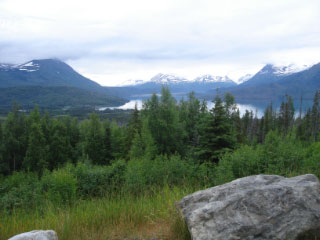 Day 65 - July 19 - Skilak Lake Road
Day 65 - July 19 - Skilak Lake Road
(Bert) Skilak Lake is a pretty blue glacier-filled lake that drains into the
famous Kenai River, probably the most important sport salmon fishing lake in
Alaska. Backed up by tall snow-covered mountains, covered with spruce, aspen and
birch at lower levels, the large lake is a worthwhile visit. I like it because
of a small rock island visible from one of the state recreational sites. The
island is a gull rookery and what is unusual is that it holds Herring Gulls, Glaucous-winged Gulls and hybrids of the two. Today when I study it through my
spotting scope, I can see 8-10 juveniles that are still in their very dark,
almost black, feathering – a plumage that is usually only seen if you can find a
gull rookery. Shari casts her fishing line into the lake, but when no fish rush
to her lure she decides the fishing is bad here and so retreats to the car. We
continue on Skilak Lake Road and stop again at Engineer Lake. While I study an
Arctic Tern colony, she fishes again and yet again decides there are no fish in
this lake even though I read a sign that says the limit on Coho Salmon is
something like 6 or so. Shari has had enough of fishing – her interest is in
catching not fishing – and we return to our campsite at Hidden Lake. I start a
campfire with the spruce logs I got back at Tangle Lakes and we roast sausage
links over the open fire.
Day 66 - July 20 - Hope
(Bert) Shari has always wanted to visit Hope, Alaska. I really don’t know
why, but maybe it is because it is one of the few places in Alaska we have not
gone. The road to Hope is a spur off the busy highway that connects Anchorage to
Homer. The pace quickly quiets down on the spur as we recede into a vibrant
green forest bordering the south end of Turnagain Arm. We continue until the
road climaxes at a diagonal yellow “END” sign and then take a narrow park road
into the Chugach National Forest and Porcupine Campground. Concerned about
making the sharp curves presumed ahead, we unhook the tow car, causing a traffic
jam on the narrow entrance road. We cause another traffic jam when I very slowly
back into a short “T” shaped site better suited for an RV half our length. The
surrounding forest is dense, dark and lush, populated by Kenai Birch
 , a
subspecies of White (or Paper) Birch that is so common in northern Wisconsin,
but these are reddish and much unlike there cousins. We decide to hike a trail,
but light rain and mud deter Shari so we walk along the paved campground road
instead. At an opening to Turnagain Arm I take some interesting photos of
pinkish red Common Fireweed against a short background of willows and longer
background of the waters of Turnagain Arm and a distant background of the
Chugach Mountains miles away. I’ve been playing with the camera settings on my
Canon 40D and tried the A-Dep setting. I like the result and use this photo
, a
subspecies of White (or Paper) Birch that is so common in northern Wisconsin,
but these are reddish and much unlike there cousins. We decide to hike a trail,
but light rain and mud deter Shari so we walk along the paved campground road
instead. At an opening to Turnagain Arm I take some interesting photos of
pinkish red Common Fireweed against a short background of willows and longer
background of the waters of Turnagain Arm and a distant background of the
Chugach Mountains miles away. I’ve been playing with the camera settings on my
Canon 40D and tried the A-Dep setting. I like the result and use this photo
 as
the screensaver on my computer.
as
the screensaver on my computer.
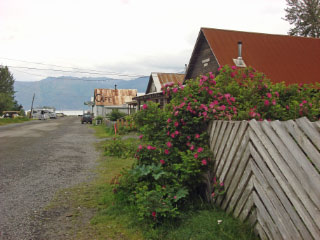 Day 67 - July 21 - Hope
Day 67 - July 21 - Hope
(Bert) The birch forest is so dark we feel trapped. We decide to walk to
Hope, about 1.5 mi. distant. Hope is a tiny town dismissed and ignored by a
transpiring clock, a gratefully preserved remnant of log cabins built by gold
panners. It reminds us of Hyder, my favorite place in Alaska. Sandwiched between
Resurrection Creek and Bear Creek, it fronts on Turnagain Arm with a short
gravel beach leading to the quicksand gray mud of the arm. We ask twice for
directions to the post office and finally meet the postmistress who is on the
phone, trying to dismiss her caller with the words, “You caught me at my busy
time”. For a post office the size of a large closet and a town that can’t have
50 residents from what I’ve seen, I wonder how much mail she sorts in a day. We
pick up our c/o General Delivery package that she has been curious about – I
wonder how many times visitors forward mail to her tiny post office. On the way
out of town we stop at the bridge over Resurrection Creek and watch a young
couple fishing for Pink Salmon. She catches one and he photographs her holding
it. Maybe we should try tomorrow.
Day 68 - July 22 - Resurrection Creek
(Bert) Fish on! I didn’t yell that, but I could have.
After watching the young couple catch salmon yesterday on Resurrection Creek,
we decide to try our luck this morning. We drive to Hope, put on our hip waders
and walk the short distance to the swiftly flowing steam. I bet I haven’t cast
three times before I’ve snagged a fish. This one is hooked on the dorsal fin, so
I release it again.
In case you haven’t fished for salmon, perhaps I should explain how it is
done and what is permitted and what is not. First of all, remember that the
adult salmon do not live in the steam; they just swim up the rushing water to
get to the calm lake where they will spawn and then die. So, the fish are only
interested in one thing and that is to get upstream. They do not eat – they are
living off the reserves gained in the ocean – and therefore are not tempted by a
fishing lure. The way to catch a fish with a fishing rod and line is to snag it.
However, there are permitted ways and disallowed ways. I cast my line upstream
and a lead weight on the line bounces downstream along the gravel and ahead of
it is a piece of bright pink yarn attached to a sharp hook. Whether or not the
yarn attracts the fish is irrelevant, although it might help annoy the fish.
After the line is taut and presumably crossing the paths a few salmon I yank on
the line and pull it toward me. The hook might sink into one of the salmon and
if it does I have a nice fight on my hands as I attempt to bring the fish to
land, mostly by just backing up onto shore. Now, if the hook got the fish in the
mouth, it is not snagging, but if it got it in the dorsal fin or the back or the
tail or the gills or the pectoral fin, then it is snagging and I am supposed to
release the fish.
(Shari) No sooner had Bert gotten his line in the water and he has a fish on
it. He yells for me to get the net. Unfortunately the fish is snagged under its
belly and we have to throw it back. He started fishing before I have my line
untangled. I can see the Pink Salmon all lined up in the shallow, clear rushing
water under the Resurrection Creek bridge in Hope, Alaska. Now this should be
catching and I can hardly wait to get going. Untangle the hook, carefully walk
on the uneven stones in the water so as not to fall on my butt, let the line out
and throw to the 10 AM position near the bridge post. The line travels with the
stream to the 2 PM position and wham, I got one. “Bert, get the net. Hurry,
before it gets off.” He tells me to back up onto shore, but the fish cleaning
table is in the way. I back a different way. It seems to take forever and that
fish is a pulling and a tugging for its life, heading toward the middle of the
stream. I back up more. Bert gets the net positioned over the fish and we have
it caught. Hurrah, my first salmon this year!
(Bert) Hurrah! Shari snags a fish, I mean catches a fish, in the mouth. It’s
a keeper! A nice plump female. I rush for the net and help her bring it in,
handing the net to her so I can take a photo of the proud fisherman, or
fisherwoman, or fisherperson, whatever is politically correct these days. Not
many minutes later I’ve got a legal fish too. This one is a male, easily
identified by its humped back, and the reason Pink Salmon are called humpies.
Between us, we snag more than a dozen more salmon, bringing them to shore, but
no more in the mouth so we release them.
(Shari) “Lets get some more”, I tell Bert. This is fun and what I call
catching. Soon it is Bert’s turn and he gets a male Pink Salmon already showing
its hump behind its head. Although less tasty, we keep it anyway. We have lots
of action but the salmon seem to get smarter. They don’t strike as often nor do
they stay on the hook. We have a lot of fun over the next two hours though. I
think both Bert and I both bring over 10 fish in but we are unable to keep them
because they are snagged. Actually the two we kept were snagged too. It is just
that they were snagged in their mouths and therefore legal. We have lots of
snags that get away too. A noisy family group comes and ends our quiet solitary
fishing and I notice that the man keeps the fish he snags in the gills. Shame,
shame! If we had done that we would have had our limit of three each in no time.
One of our reels is broken and the line unravels easily. After two hours, Bert
tires of fishing with the broken reel and starts to clean the two we have in our
bucket. I continue and get one strike after another until a honker of a fish
catches my lure and snaps it off the line. I restring another lure to the weight
but I think I made it too short and the next 50 flings bring nothing to shore. I
too decide to call it a day after Bert finishes cleaning.
(Bert) I clean the two fish while Shari continues fishing. Pink Salmon are
sure hard to clean – perhaps the hardest I’ve gutted and deboned – and it takes
me a long time. In a book I read, it describes native Alaskans catching hundreds
of salmon in a gill net and Grandma cleans salmon with her ulu at the rate of
one per minute. She could have done 20 by the time I’ve finished our two. Well,
the grandma that lives with me will be preparing fish for dinner tonight – fresh
by just 6 hours.
We move campgrounds to Williwaw USFS, a pleasant place we camped years ago,
but in a downpour so severe we never saw anything beyond the inside of our RV.
This time it is gray skies but no rain and we circle the campground and see a
familiar RV. It is Chris and Curt’s and we park at an open site adjacent to
theirs. Several times in the next two hours I check if they have returned with
their car and finally at 5:30 we join them for social hour, relating stories of
how we have spent the past week. My now the rains have come and we face the same
downpour we did last time we visited. Maybe tomorrow we can try some of the
trails – if it dries out, that is.
(Shari) We head back to Porcupine Campground and check out an hour before due
time. Next stop is near Portage Glacier at the U.S. Forest Service campground
called Williwaw. Since we now have a golden age card, we get to stay at these
campgrounds for half price. Hey, there are some advantages to old age. We used
the discount twice before, once paying $5 per night and another time paying $7.
At Williwaw it is $9 per night. I guess it’s the 26-mi. proximity to Anchorage
that makes it more expensive. Tomorrow we will leave R-Tent-III at the
campground and take the ferry with our car to Cordova for three nights and three
days. We have roughed it for the past week at these cheap campgrounds. It is
time to pamper ourselves a little bit.
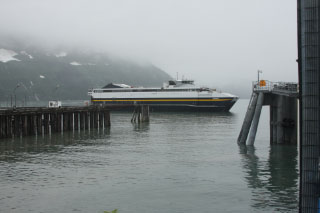 Day 69 - July 23 - Whittier and Prince William Sound
Day 69 - July 23 - Whittier and Prince William Sound
(Bert) In the rain at Whittier, Shari searches for a cache but I find it
first and then I photograph a Least Sandpiper in the grass before we go off to
search for another geocache. This one we can’t find before it is time to line up
for the ferry. A half dozen Red-necked Phalaropes, now retreating to their dull
winter plumage and absent of red, float in the harbor in front of the M/V
Chenega as it pulls up to the dock. The almost-new ship impressively “spins on a
dime” in a maneuver that turns itself 90º without any forward or backward
movement. It is a high speed 235-ft. catamaran, cruising at 32 knots. In fact,
it is so fast it is hard to remain focused on pelagic birds. Further complicated
by fog, rain and whitecaps, the birds are sparse, yet I do see Pomarine and
Parasitic jaegers, Marbled Murrelets and a pair of all black alcids I can only
deduce are Rhinoceros Auklets. Briefly, I watch a few Dall’s Porpoises and Sea
Otters, but no whales today. In the non-birding interim, Shari and I play Gin
Rummy, although when I beat her 108-94 and 127-18 she looses interest in
continuing. We arrive in Cordova and drive our car off the ferry and to a hotel
and restaurant, eating a late 8:30 PM dinner with view of the harbor in the
rain.
(Shari) Bert is trapped and has to play cards with me. He had so wanted to
stand for three hours on the bow of the ship looking for feathery friends, but
today’s ferry to Cordova is a fast catamaran with no outside access to the
front. The weather is lousy with hard rain, clouds and limited visibility. The
catamaran is very new and looks like a private yacht with wooden floors and blue
carpeted aisles in modern décor. To play Gin Rummy, we choose to sit at
airplane-style chairs centered around tables that are scattered throughout the
windowed front of the boat. I win most of the first few hands but since we play
to 100 points, Bert wins the match with two scoring whoppers leaving me with a
mitt full of high point cards. The second match is not better and I quit. The
rain is still coming down when we arrive at Cordova. We learn from the
naturalist on board that Cordova, population about 2500, is not a tourist town
but a working fishing town much like old Alaska. She suggests a place for us to
stay the night and we take her up on it. The Reluctant Fisherman sits on the
harbor’s edge and we have a nice view of the docked fishing boats while we share
a fisherman’s platter and onion rings. Retiring to our room we catch up on long
overdue E-mails before turning off the lights. I can hear the rain pelt the
windowpane as I fall asleep and hope that it stops before morning.
Day 70 - July 24 - Cordova
(Shari) As I peek out the window blinds this morning I still see wet pavement
and small droplets of water hitting the puddles. Oh darn! We go to the lobby to
eat the hotel’s skimpy Continental breakfast before heading to the U.S. Forest
Service office to get the lowdown on bird sightings. Arriving at our B&B, I am
shown to a comfortable room with private bath across the hall. I am told the
whole house is ours to use but all I want is Internet access to download the
geocache information. I forgot the cable that connects the computer to May and
decide to enter seven caches by hand. Bert is outside pacing in the rain waiting
for me to get going and making me nervous.
(Bert) Rain, rain, go away! Come again another day! We stop at the Forest
Service and talk to Milo, a local birder and photographer. He sells me a new
version (April, 2008) of “The Birds of Cordova and the Copper River Delta – A
Checklist” compiled by Aaron Lang, another birder I’ve met in my travels to
Nome. Milo doesn’t know of any particular rarities in the area at this time,
except for a Morning Dove that hit a resident’s window. We check in at Wildberry
B&B where we will spend the next two nights and while Shari attempts to download
geocaching information, I walk in the rain toward the bay, finding a dozen bird
species including Rufous Hummingbird, the first I’ve seen on this trip, and the
only regularly occurring hummingbird in Alaska.
(Shari) Off we go into the wild gray wet yonder to explore Cordova. First
place is the fisherman memorial and a supposed cache. Unfortunately I am going
blind on this one and only have coordinates and don’t know what size or anything
I am looking for. We do not find it. Instead we walk across the street to the
native museum and browse the art displays and the gift shop before taking one of
the roads along the water’s edge. We pass another cache location and while Bert
takes pictures of the displayed maps, I find the cache. Hurrah! I do not like to
be out of the car much though since the rain is really coming down hard now.
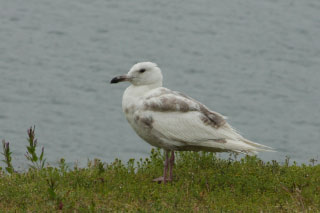 (Bert) We head out of town toward Orca Inlet, stopping at a pullout when I
see a whitish gull I’m not sure I can identify. I take multiple photos of the
large immature gull for later analysis. [With reference books, I deduce it is a
hybrid, a cross between Glaucous and Glaucous-winged gulls]. Shari is intent on
finding ripe berries and while walking in the rain I find three salmon berries,
appropriately salmon-colored and nicely edible, but none others among hundreds
of blossoms. Weatherwise, nature is two weeks late here too.
(Bert) We head out of town toward Orca Inlet, stopping at a pullout when I
see a whitish gull I’m not sure I can identify. I take multiple photos of the
large immature gull for later analysis. [With reference books, I deduce it is a
hybrid, a cross between Glaucous and Glaucous-winged gulls]. Shari is intent on
finding ripe berries and while walking in the rain I find three salmon berries,
appropriately salmon-colored and nicely edible, but none others among hundreds
of blossoms. Weatherwise, nature is two weeks late here too.
(Shari) We eat lunch in the car, sandwiches made from meat and bread that I
brought from home. Heading along Lake Eyak, the solid gray sky meets solid gray
water as we wind our way along a solid gray gravel road. We don’t see much at
all but do admit the scene would be simply gorgeous on a sunny day. Back in town
we first visit the historical museum and library, then take another road in
another direction and finally end up for pizza and a beer in town. The
optimistic side of me thinks the sky looks lighter and the gray is breaking up.
At least the rain stopped.
(Bert) We drive Power River Road, along Eyak Lake, through dense wet forest
with frequent gaps on our right of views of the elongated lake and then rushing
river. On the gravel road we scare up a Semipalmated Plover, then two more, then
a fourth. On each occurrence the plover repeatedly flies ahead of us along the
gravel, stopping if we stop, but never attempting to escape into the forest. Not
until the road widens for a broad gravel turnout or gravel side road do the
plovers escape. It’s a curious fact of nature, the plover being out of its usual
element here in the forest, familiar with gravel but afraid of the dense
confinement on either side. We reach the end of the road and turn around at a
spot where we can see a thin waterfall descending from mountains still snow
capped, dropping hundreds of feet through the forest to the river, where I see a
Dipper alight on a snag over the rushing water.
Shari is concerned about having enough gas for our 100-mi. roundtrip tomorrow
so I refuel at $5.549/gal. with regular. The diesel pump registers just 0.1 cent
less than six dollars per gallon. We visit a museum with a complete skeleton of
an Orca Whale hanging from the ceiling, apparently one of only a handful of such
displays in the world. I’m impressed with the large alligator-like mouth lined
with big sharply pointed teeth and the dorsal flippers reinforced with five
fingers. Before dinner we drive one more road, this one culminating at Hartney
Bay where thousands of Glaucous-winged Gulls gather tightly. At the pizza
restaurant I order an I.P.A. beer which the waitress doesn’t recognize as India
Pale Ale, so I tell her the story of how the English beer got its name. Another
diner at the adjoining table completes the story, adding that it is the high
alcohol and high hops content that gave it the longevity to round Cape Horn by
ship in the 17th century.
Day 71 - July 25 - Cordova
(Bert) No rain! Perfect timing, for today we intend to drive Copper River
Highway through the Copper River Delta to Child’s Glacier and the Million Dollar
Bridge. We stop first at Eyak River Trail and hike through the rainforest. Shari
soon quits because the trail is difficult, including many roots and rocks. I
continue because I want to explore this fascinating habitat. Dozens of European
Black Slugs lie along the path, their shiny black dung-like bodies are repulsive
at first but intriguing when I investigate them further. I later learn the slugs
were introduced by Filipinos now living in the area as they enjoy eating the
young slugs, a relative of the snails I wouldn’t hesitate ordering at a
restaurant as escargot. Unfortunately, the introduced slugs have no predators
and they readily reproduce, survive the winter and consume all vegetable matter
in their path. Biologists are concerned they will spread to the Copper River
Delta, an economically significant area because of the spawning salmon and the
main livelihood of the community as well as a habitat for the huge numbers of
Dusky Canada Geese and Trumpeter Swans and a significant population of Moose.
Continuing on the gravel highway, we have wetlands on our right reaching to
the not-visible sea and on our left glaciated mountains. Most prominent are
Sheridan Glacier and Saddlebag Glacier which spill their broad ice fields into
braided streams across vast gravel beds surrounded by willow covered islands.
(Shari) Two caches, two owls, two moose and a
supercalifragilisticexpealidoucious glacier. Even though it was cloudy and/or
drizzly that just about explains our day today. It just goes to prove that there
is no such thing as bad weather: just poor equipment and a bad attitude. Armed
with our raincoats, boots, walking stick and layers of clothes we take off in
the car down the 48 mi. Copper River Highway. Bert stops a lot to look at birds.
I read. Our first good stop is at Alaganik Slough where I find a cache on the
boardwalk and we see a Short-eared Owl perched on a stubby tree.
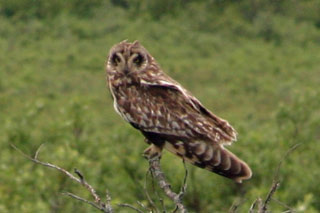 (Bert) Our next stop is Alaganik Slough where we walk on a boardwalk into the
marshlands. Shari finds another geocache and I photograph one of the dozen
Varied Thrushes I see today. Although the habitat looks inviting for ducks, I
only find a few Ring-necked Ducks besides one family of swans that includes five
half-grown cygnets and a family of the Dusky Canada Geese. I walk along another
path, this one built on Geoblock, a connected framework of rectangular sections
of recycled plastic, perforated with silver-dollar-sized holes. The narrow
walkway provides stable footing without damaging the marsh environment. I walk
through an inch of water, but if I were to step aside into the marsh I would
sink several inches to a foot immediately and my forward progress would be
nearly impossible. This is the first time I’ve encountered this design and it
certainly should be used elsewhere as well.
(Bert) Our next stop is Alaganik Slough where we walk on a boardwalk into the
marshlands. Shari finds another geocache and I photograph one of the dozen
Varied Thrushes I see today. Although the habitat looks inviting for ducks, I
only find a few Ring-necked Ducks besides one family of swans that includes five
half-grown cygnets and a family of the Dusky Canada Geese. I walk along another
path, this one built on Geoblock, a connected framework of rectangular sections
of recycled plastic, perforated with silver-dollar-sized holes. The narrow
walkway provides stable footing without damaging the marsh environment. I walk
through an inch of water, but if I were to step aside into the marsh I would
sink several inches to a foot immediately and my forward progress would be
nearly impossible. This is the first time I’ve encountered this design and it
certainly should be used elsewhere as well.
Driving back through the slough I see a Short-eared Owl take flight and
notice where it lands again in the distance. Slowly, very slowly, I creep up to
the spot, remaining in the car which acts as a blind. We watch the owl for 7
min., getting ever closer and in excellent view of the perched bird, even seeing
the tiny feathers protruding from its head like horns.
(Shari) Next we hike in an enchanted forest and I expect to see Alice in
Wonderland scamper out in front of me with her friends. If not Alice at the very
least I should see some leprechauns. The forest is full of tall stately trees
reaching to the sky as if support columns holding up the clouds. Underneath, the
forest floor is covered with moss and ferns. Every turn of the path is a wonder
of green. The only negative on that walk are the stairs. Hundreds of steps to go
up then back down. The 0.8 mi. seems like 1.8. At the end of the trail I find
the ammo can (not on published coordinates I might add) and finding the geocache
reinvigorates me for the walk back. On the way back, Bert points out a Great
Horned Owl and we watch it call for its momma for many minutes.
(Bert) Our next stop is the Haystack Trail where Shari expects to find a
geocache at its end at the marsh overlook. The trail is an almost constant
series of wooden steps climbing in a spruce forest, dark woods where you’d
expect gnomes, goblins, leprechauns and alux to jump out at any moment. Instead,
I hear an unfamiliar loud nasal jeer IK, oft repeated in a demanding sort of
way. The sound comes closer, high in the spruce. Just below the canopy I see
where the owl has landed. It’s a juvenile Great Horned Owl, recently fledged and
still demanding to be fed. Later, on our return hike after Shari has found the
geocache, I see the owl again and now hear a second youngster nearby. Another
good bird of the day is a Brown Creeper, my first of the year. By the time we
exit Haystack we have only traveled about 25 mi. by car today and half the
distance to the end of the road, yet it is 2 PM.
(Shari) Back at the car, I notice it is 2 PM and we have only gone 20 mi.,
not even half the distance to the end of the road. We had better hurry. When
Bert stops yet again to look at a duck; I just have to say, “You are not going
to stop at every darn duck on the route, are you?” He gets my point and speeds
up. At the end of the road is an old one lane bridge. We stop to take pictures
before crossing. Again we stop in the middle of the bridge to take more
pictures.
(Bert) I drive faster now until we reach Million Dollar Bridge. Cut into the
huge steel bridge is the date 1910, a time when a million dollars was a lot of
money. The road ends just a bit past the bridge, originally used for a railroad
that carried copper from mines to seaport. There is always talk of extending the
highway beyond, thus freeing Cordova from its landlocked status, but the 1964
earthquake and the continuous shifting of the delta land beneath the road makes
the task formidable. Apparently, residents are happy with the status quo as it
leaves their quiet friendly village remote with limited outside influence.
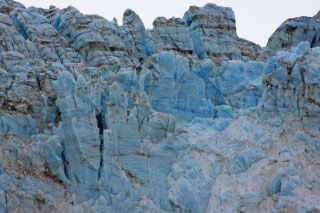 (Shari) To our left is a fantastic blue glacier and to our right are a fast
flowing river and another glacier. At the end of the road is a forest service
campground and just about the best setting for a campground I have ever seen. I
wish we could be staying here tonight. Child’s Glacier is just a stone throw
over the river and we can hear its creaks and groans while in the campground.
Signs warn us to watch the calving process and be prepared to run like mad. A
few years ago, a hunk of ice calved and caused a wave 30 feet high - certainly
high enough to drown us. The glacier groans and caves and we marvel and snap
more pictures. Don’t you just love digital? On the way home we see two moose
munching on the willows that grow so profusely along the roadside.
(Shari) To our left is a fantastic blue glacier and to our right are a fast
flowing river and another glacier. At the end of the road is a forest service
campground and just about the best setting for a campground I have ever seen. I
wish we could be staying here tonight. Child’s Glacier is just a stone throw
over the river and we can hear its creaks and groans while in the campground.
Signs warn us to watch the calving process and be prepared to run like mad. A
few years ago, a hunk of ice calved and caused a wave 30 feet high - certainly
high enough to drown us. The glacier groans and caves and we marvel and snap
more pictures. Don’t you just love digital? On the way home we see two moose
munching on the willows that grow so profusely along the roadside.
(Bert) In view from the bridge is Child’s Glacier; we drive closer, using the
campground access road. I’m surprised how close we can drive to the glacier.
Only a narrow river separates us from the 300 ft. wall of glacial ice and we can
hear it groaning and cracking and see ice waterfalls. In fact, a sign posted
where we stand says that waves caused by glacier calving can reach our feet
20-50 times per year and in 1993 a wave went over the land and rose 30 ft. above
our heads. Shari drives back to Cordova and we stop only a few times, once to
see a pair of Moose and then a magnificent view of Sheridan Glacier and
snow-capped mountains reflected perfectly in a silvered lake at 6:50 PM.

(Shari) We pull into a restaurant parking lot at just about 7:30 PM. No one
acknowledges our standing presence for at least 5 min. so we sit at a table of
our choosing. Another 5 min. go by and no one acknowledges us. We leave. The
Powder House restaurant does not get our business tonight. We drive around town
and finally settle on a small diner selling Mexican food. Cordova needs a good
restaurant and doesn’t even have a national fast food chain restaurant. There is
no MacDonald’s, nor Dairy Queen, not that we wanted one though. Every small town
in the south has a Dairy Queen. And it is not that Alaskans don’t eat ice cream.
I understand they eat more ice cream per capita than any other state. So where
is the Dairy Queen? As I write this, back at the B&B, I notice the blue sky out
the window. After six days of clouds and another five days of rain, it looks
like tomorrow might be nice. Hurray!
Day 72 - July 26 - Prince William Sound
(Bert) Much better seas and clearer skies, this morning’s ferry across Prince
William Sound is far more productive in wildlife watching. We are again on the
M/V Chenega and I find a plaque saying it was christened December 2004, making
it an even newer ship than I first thought. The naturalist Lucy, only a month or
two into her new job, tells us of the whales we might see. I am interested in
the Minke Whale since I’ve only seen them once before and that was in the
Labrador Straits. She tells me she has seen them on every trip. Not so this
time! In fact, we find no whales at all. On the up side, I find a Sitka Deer on
the shore of an island, 23 Sea Otters, 1 Harbor Seal, 4 Harbor Porpoises, 3 pods
of Dall’s Porpoises of about five each, and 3 Steller’s Sea Lions. Birding is
good too, with most of the regular species plus Fork-tailed Storm-Petrel and
Surf Scoter.
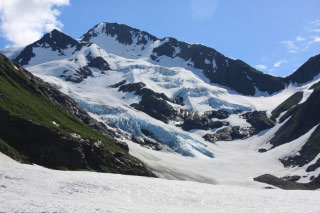
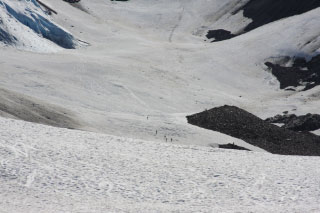
Byron Glacier on left. Close-up image on right shows 7 hikers at base
of glacier, also present in photo on left.
Day 73 - July 27 – Girdwood and Byron Glacier
(Bert) Our visit to Girdwood is the tourist trap type experience that is not
high on my list of favorite things to do, so maybe Shari will tell you about
that. Instead, I enjoy more what we do this late afternoon. Past the turnoff for
the better known Portage Glacier is a hiking trail to Byron Glacier. In 1996 we
saw the glacier from a distance; today we hike the 1.6-mi. roundtrip trail
nearly to the edge of the glacier. Through a short willow forest, alongside a
snow and glacier fed rushing stream, the pathway is sprinkled with yellow Large
Leaf Avens, tiny white flowers of Coast Saxifrage with its brilliant red stems
and an occasional Mustard White butterfly. Blue skies and a relatively warm day
brighten the mountain views and when we reach the glacier the whiteness dazzles
my eyes. Fronted by acres of unmelted snow, the drift must be at least 50 ft.
deep. We watch adventurous souls trudge across the snow and one big group
continues to climb beyond the firn line of the glacier. My photos of the full
breadth and height of Byron Glacier show the hikers as tiny black dots in the
lower right corner. I hand my camera to Bill to try several photos of us
standing with a backdrop of the glacier behind us; however, it takes a full
flash to illuminate our faces against the brightness of the snowpack.
We make it back to Williwaw campground in time for 5 PM Happy Hour, joined by
Bill & Ginny and Steve & Nancy. They all settle down in lawn chairs, while I
chop wood. Taking advantage of Bill’s splitting axe, I split all of the spruce
logs I’ve been carrying in my trunk, an exhausting task. The narrowly split
firewood, though, makes for a nicely burning warm fire and we stay out for a
couple of hours and then when the others leave Shari and I enjoy hotdogs roasted
over the open fire.
(Shari) To our surprise, Bill and Ginny knocked on our door yesterday. They
are parked not far from us and invited us to play cards. We had a great time,
especially when the women trounced the men two games out of two. Today they
invited us to accompany them to Girdwood and the Alyeska ski area. Upon first
viewing, it is disappointing. I think I was expecting a smaller version of
Breckenridge. Instead, we find just one or two stores, lots of condos and
individual housing units, and one great huge resort. We stop at the resort and
while the men sit in the lobby checking E-mail, Ginny and I shop. We eat lunch
at Bake Shop where we fill up on homemade beef vegetable soup with free refills.
The best part of the trip is the road to Crow Creek Mine, a national historic
site. We do not pay the $15 per person to gold pan there but watch many others
who do pay that or the $5 entrance fee to enter the grounds. Some of the oldest
buildings in the area are preserved on the well manicured hillside. The mine
shut down not because the gold gave out but because the machinery broke. Some
people stay the summer and I guess two groups make a living from their gold. The
man taking tickets gives a demonstration of the gold panning technique and we
see about half teaspoon of gold in his pan. He seems surprised - I bet he uses
the same pan for every demonstration - and tells us the amount of gold is worth
about $100 on today’s market. Later we drive to Byron Glacier and take the 0.8
mile walk to the edge of a snow pile. We see some people far in the distance
near the glacier and later find out that Steve and Nancy - they are also parked
close to us at the same campground - walked there to get a geocache. All six of
us gather around a fire made with freshly split wood thanks to Bill’s splitter
and Bert’s muscle and have a long fun Happy Hour.
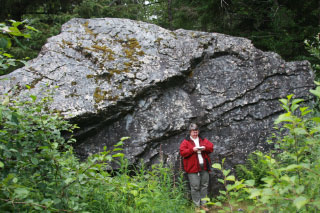 Day
74 - July 28 - Williwaw
Day
74 - July 28 - Williwaw
(Bert) We spend one more day at Williwaw campground, another with good
weather, and this time we hike around the many nicely paved or boardwalk trails.
One of the geocaches is of a different kind: a natural feature that is to be
found, measured and logged on the web site, but without a cache of goodies or
logbook. This one interests me because it is the one of the largest erratics I
have ever seen. A few days ago Steve measured it and estimated its weight based
on information he got from the web. I forgot what the answer was, but this
erratic is as big as a small house. What enormous strength has a glacier to
deposit a boulder as large as this! Steve wondered why no sign marks the
remarkable feature and asked an attendant at the nearby visitor’s center. He
learned that a geologist decided this boulder could not be termed an erratic
because its composition matches the surrounding mountains and therefore was not
carried from another geological terrane. Nonetheless, the boulder was carried at
least part of the way and I find that amazing.
Day 75 - July 29 - Anchorage
(Bert) We leave Williwaw and move to a small campground in the midst of
Anchorage, a bit of a rundown place, but at $35 per night it is quite a bit
cheaper than the other campgrounds.
Day 76 - July 30 - Anchorage
(Bert) A day of errands, we preface our store visits with one to Potter Marsh
where our friends Carl and Sandy are camp hosts. They are not at their RV when
we arrive, so I leave a note wedged in the door handle. We check out the new
boardwalk that was just beginning construction when we visited here in early
June. Now almost complete, it extends far into the marsh, offering a close-up
view of its denizens. I brought along my 100-400 mm lens to test out its
features. Yesterday I was preparing it for shipment back to the Canon repair
center. After 10 days of drying out the lens following my 4-wheeler mishap in
Gambell, I could not get the lens to function. I tried for several days
thereafter, but the auto-focus, image stabilization and illumination detection
would not operate and therefore the camera shutter would not excite. A call to
the repair center sounded ominous and that the lens probably was beyond repair
because too much electronics was damaged. So I was amazed yesterday when the
lens worked without apparent problem. Today I test it on shots of Mallards,
Red-necked Grebes, and Wilson’s Snipes  , all of which photograph well, even when
I try multiple setting options. The best bird I photograph is a very dark
juvenile Bald Eagle begging for food from a perch in a tall dead tree at the
edge of the marsh. A few hundred feet in either direction are the white-headed
adults ignoring the pleas. This family is the same one I photographed in the
nest on June 1 and I learn later that the juvenile fledged yesterday.
, all of which photograph well, even when
I try multiple setting options. The best bird I photograph is a very dark
juvenile Bald Eagle begging for food from a perch in a tall dead tree at the
edge of the marsh. A few hundred feet in either direction are the white-headed
adults ignoring the pleas. This family is the same one I photographed in the
nest on June 1 and I learn later that the juvenile fledged yesterday.
Day 77 - July 31 - Anchorage
(Bert) Shari wonders where all my ambition comes from today. I take the car
to the driveshaft mechanic to have the Remco disconnect adjusted so that it is
easier to connect and no longer makes a scraping noise on starts, I get the new
tires checked that we bought yesterday and buy a special adapter for filling air
on the RV tires, and then I return to accomplish a long list of cleaning and
mechanical checkup on both the car and RV, tasks I usually procrastinate for
months. At 7 PM we meet Carl and Sandy at Gallo’s, a favorite Mexican restaurant
– they called last night after seeing our note in the door – and have a
wonderful time catching up on news since our Mexico-Belize caravan trip with
them in 2005.
Day 78 – August 1 - Anchorage
(Bert) While Shari and I are searching for geocaches we walk past the
municipal baseball stadium and I see the players practicing. I ask one of them
if there is a game tonight and he answers “At 6 PM”. Shari isn’t interested, so
she stays back while I return just before the game starts, purchase my $5
ticket, get a free T-shirt, buy a $2 bag of popcorn and take a seat in the
covered bleachers just behind home plate. In my position and through binoculars
I can see the expressions on the pitcher’s face as he assents to the catcher’s
pitch suggestion, turns his eyes to first base to check for the anxious
base-stealing player, and grimace as he fires the ball over home plate. The
umpire rotates 90º, stoops slightly, points a crooked finger and announces,
“Strike!” The Anchorage Bucs are playing the Alaska Oilers from Soldotna in the
last game of the season. The next ball is foul, arcing over the box seats and
into the parking lot. With each foul ball leaving the stadium – and there are
dozens – the announcer tells us, “The foul ball is sponsored by ___” filling in
the blank with a different vendor each time. Batters from the visiting team are
introduced with a prefacing forename that designates the college team mascot
from which they originated. I do not recognize most of them, but do pick up on
the Aggie and Longhorn players I know are from Texas A&M and Texas. Not wanting
to be late for 8 PM dinner, I leave during the sixth inning when the Oilers are
ahead of the Bucs 3-0.
Day 79 – August 2 - Anchorage
(Bert) Early in the morning while Shari is still sleeping, I finish my
subregional Texas report for North American Birds for the summer season. The
deadline isn’t for several weeks, but these extra days in Anchorage have given
me opportunity to gather the data and write the report. Shari heads to
Anchorage’s Saturday Market and that gives me quiet time for editing my book on
Belize, making the changes specified by the editor. I am happy with my progress,
but still recognize I have more work ahead of me. I hope I can have it finished
before our Mexico trip next January.
 Next
Day
Next
Day  Table
of Contents
Table
of Contents
 passed R-Tent-III on the way from the river to their parked
vehicles. Nonetheless, Shari assembled our fishing gear and went to the tackle
shop to buy more gizmos and do-hinkies to attach to the end of the line. She has
been calling the hotline and getting the daily salmon count at local rivers.
When she heard that 18,000 entered the Kasilof River yesterday, she decided that
today was the day to catch fish. Consulting her tide chart she tells me we will
go at the 5:30 PM high tide. A bit earlier I already see fishermen passing
R-Tent-III on the way to the river, so I suggest we better leave now before the
river is reduced to combat fishing only.
passed R-Tent-III on the way from the river to their parked
vehicles. Nonetheless, Shari assembled our fishing gear and went to the tackle
shop to buy more gizmos and do-hinkies to attach to the end of the line. She has
been calling the hotline and getting the daily salmon count at local rivers.
When she heard that 18,000 entered the Kasilof River yesterday, she decided that
today was the day to catch fish. Consulting her tide chart she tells me we will
go at the 5:30 PM high tide. A bit earlier I already see fishermen passing
R-Tent-III on the way to the river, so I suggest we better leave now before the
river is reduced to combat fishing only.  Day 65 - July 19 - Skilak Lake Road
Day 65 - July 19 - Skilak Lake Road  Day 67 - July 21 - Hope
Day 67 - July 21 - Hope  Day 69 - July 23 - Whittier and Prince William Sound
Day 69 - July 23 - Whittier and Prince William Sound  (Bert) We head out of town toward Orca Inlet, stopping at a pullout when I
see a whitish gull I’m not sure I can identify. I take multiple photos of the
large immature gull for later analysis. [With reference books, I deduce it is a
hybrid, a cross between Glaucous and Glaucous-winged gulls]. Shari is intent on
finding ripe berries and while walking in the rain I find three salmon berries,
appropriately salmon-colored and nicely edible, but none others among hundreds
of blossoms. Weatherwise, nature is two weeks late here too.
(Bert) We head out of town toward Orca Inlet, stopping at a pullout when I
see a whitish gull I’m not sure I can identify. I take multiple photos of the
large immature gull for later analysis. [With reference books, I deduce it is a
hybrid, a cross between Glaucous and Glaucous-winged gulls]. Shari is intent on
finding ripe berries and while walking in the rain I find three salmon berries,
appropriately salmon-colored and nicely edible, but none others among hundreds
of blossoms. Weatherwise, nature is two weeks late here too.  (Bert) Our next stop is Alaganik Slough where we walk on a boardwalk into the
marshlands. Shari finds another geocache and I photograph one of the dozen
Varied Thrushes I see today. Although the habitat looks inviting for ducks, I
only find a few Ring-necked Ducks besides one family of swans that includes five
half-grown cygnets and a family of the Dusky Canada Geese. I walk along another
path, this one built on Geoblock, a connected framework of rectangular sections
of recycled plastic, perforated with silver-dollar-sized holes. The narrow
walkway provides stable footing without damaging the marsh environment. I walk
through an inch of water, but if I were to step aside into the marsh I would
sink several inches to a foot immediately and my forward progress would be
nearly impossible. This is the first time I’ve encountered this design and it
certainly should be used elsewhere as well.
(Bert) Our next stop is Alaganik Slough where we walk on a boardwalk into the
marshlands. Shari finds another geocache and I photograph one of the dozen
Varied Thrushes I see today. Although the habitat looks inviting for ducks, I
only find a few Ring-necked Ducks besides one family of swans that includes five
half-grown cygnets and a family of the Dusky Canada Geese. I walk along another
path, this one built on Geoblock, a connected framework of rectangular sections
of recycled plastic, perforated with silver-dollar-sized holes. The narrow
walkway provides stable footing without damaging the marsh environment. I walk
through an inch of water, but if I were to step aside into the marsh I would
sink several inches to a foot immediately and my forward progress would be
nearly impossible. This is the first time I’ve encountered this design and it
certainly should be used elsewhere as well.  (Shari) To our left is a fantastic blue glacier and to our right are a fast
flowing river and another glacier. At the end of the road is a forest service
campground and just about the best setting for a campground I have ever seen. I
wish we could be staying here tonight. Child’s Glacier is just a stone throw
over the river and we can hear its creaks and groans while in the campground.
Signs warn us to watch the calving process and be prepared to run like mad. A
few years ago, a hunk of ice calved and caused a wave 30 feet high - certainly
high enough to drown us. The glacier groans and caves and we marvel and snap
more pictures. Don’t you just love digital? On the way home we see two moose
munching on the willows that grow so profusely along the roadside.
(Shari) To our left is a fantastic blue glacier and to our right are a fast
flowing river and another glacier. At the end of the road is a forest service
campground and just about the best setting for a campground I have ever seen. I
wish we could be staying here tonight. Child’s Glacier is just a stone throw
over the river and we can hear its creaks and groans while in the campground.
Signs warn us to watch the calving process and be prepared to run like mad. A
few years ago, a hunk of ice calved and caused a wave 30 feet high - certainly
high enough to drown us. The glacier groans and caves and we marvel and snap
more pictures. Don’t you just love digital? On the way home we see two moose
munching on the willows that grow so profusely along the roadside. 

 Day
74 - July 28 - Williwaw
Day
74 - July 28 - Williwaw